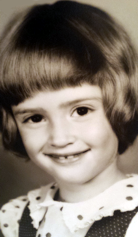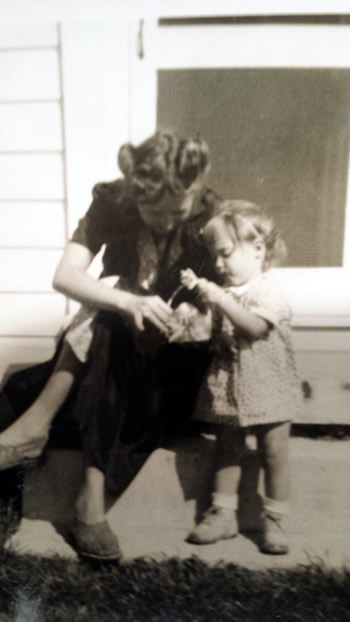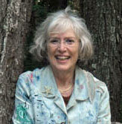CapeWomenOnline - Where Cape Women Shine
Your local venue for the women of Cape Cod to share their ideas, experiences and resources while inspiring each other in their life's journey
Inspire . Encourage . Network . Share
Hair Peace
by Beverly Ryle

A few days after my first granddaughter's birth, I held her in my arms, looked down at the tousled black full head of hair she came into the world with and said a silent prayer. "Please don't let her waste as much of her life fussing and worrying about her hair as I have."
To date, my petition seems to have had very little effect on my granddaughter. The last time I saw her long tresses they were tastefully tinged with magenta. But I do mark this event as a turning point in my lifelong struggle to arrive at some kind of hair nirvana—a stylish hairdo that is right for me and can be maintained effortlessly by a woman whose dexterity with a brush and blow dryer is nil.
Not only have I always been unskilled in the physical care of what should be my crowning glory, there are psychological complications as well. My mother had gorgeous thick auburn hair that fell to her waist when not neatly braided into coils on the top of her head.
The little girl who watched her brush that glorious mane had fine, straggly hair which was unsuitable for braids, too wispy to stay in place and best managed with a bowl cut and bangs like the little boy icon of shoes. What female child wouldn't spend her later life trying to escape from an identification with " I'm Buster Brown, and I live in a shoe. That's my dog, Tige, and he lives there, too."
In my preteen years a well-meaning aunt, who empathized with my hair dilemma more than my mother, tried to help by giving me a permanent in her backyard a few days before I entered junior high in 1956. Performing this task "en plein air" was necessary because of the toxicity of the ammonia-based lotion used to break down the hair's structure, so it would take the shape of the metal rods it was rolled around.
It is indicative of my desperation to fit in with the more full bodied (hair and otherwise) girls in school that I was willing to endure the six-hour process of rolling, basting, neutralizing and waiting for the hair to dry. Unfortunately, the outcome was not the soft curls I had anticipated as a reward for my endurance.
To celebrate the completion of the smelly, messy ammonia part, my aunt and Mother made gin and tonics and although they set a timer to be sure I didn't "bake" too long the neutralizing step was delayed which resulted in rows of tight ringlets. My aunt, by then slurring her words, assured me that it would soften in a few days and my mother was upset with me for making a fuss, so my tears flowed into a pillow case which like my hair, smelled like the ammonia lotion every time it got wet.
Despite my best effort to observe and copy the hairdos of the most popular girls, I spent my high school years either being hopelessly out of step—when their hair was long and straight, mine was short and curly; when mine was long and straight theirs was short and curly—or unsuccessfully emulating stars like Joanna Harris.
Her status as the most popular and best student in the class served me well as motivation to work harder, but her perfect pony tail that kept its cork screw shape from her first period class in the morning through leading cheers at a basketball game that night, drove me to distraction. Even after sleeping on 2-inch metal rollers all night, my curls dissolved before I got off the bus.
Although I should take full responsibility for my last high school hair disaster, I'd prefer to blame Seventeen Magazine and a feature article about how to shine at your senior prom. After having my medium length, soft waves (permanents had improved by then) molded and affixed in place with hair spray at the beauty parlor, I pulled out the photograph I had clipped from the article and the hairdresser dutifully glued a glob of glitter above my bangs. The effect was rather like a third eye and my date, instead of finding my adornment alluring, complained about it dropping on his tux all night.
In college, I found my own crowd, one that favored sitting around dorm rooms singing Baez songs, that simplified hair to let it grow and let it hang. It was a style I kept for the twenty years of my first marriage, because it required no more than a barrette or elastic band and because my first husband liked it when I wore my hair in two pony tails like a little girl. I have a Thanksgiving photo of me with long braids (finally) wearing one of the Indian headbands I made with the kids.

After being divorced, I fell under the influence of another man, a photographer whose unsavory flattery substituted for self-esteem, until I got into recovery and cut my hair into the short wedge being worn by high fashion models. Although the look was in sync with the style of the day, it didn't match me and as I rediscovered myself, I grew it back to mid-length and settled into a better shaped, highlighted version of the bowl cut, which had been renamed a bob.
As white streaks became more widespread, I found myself in the beauty parlor more often than I enjoyed and shortly after uttering the hair prayer to my newborn granddaughter, decided to let my hair be whatever color it wanted to be. To my surprise I was quite content with the outcome until I noticed aging came with an another hair manifestation, unruliness, or what I've come to call the Einstein look.
Photographs courtesy of Beverly Ryle
Still as unskilled, despite the patient instruction of a dozen hairdressers, in the shaping step after towel drying, I would catch myself returning to hair envy when I saw a smoother coiffed woman my age. This last obstacle in coming to peace with the state of my hair was removed a few days after I delivered a eulogy at my father's funeral in which I courageously spoke about the true nature of our relationship.
Like all gifts of grace, it came unexpectedly when I opened a drawer and found a card with a photograph of the fabric art of Deidre Scherer, the woman whose work illustrated the book, When I Get Old I Will Wear Purple. The elder woman in the image has her hand clasped below her chin, her dark eyes are framed with thick dark brows and look directly at you. The words below her read "Stand before the people you fear and speak your mind—even if your voice shakes" a quote by Maggie Kuhn, the founder of the Gray Panthers.
Her hair is white and jagged, yet every strand is as firmly set in place as her jaw—a suitable mantle for a woman of conviction.

In her professional roles as a career counselor and business consultant, Beverly Ryle has been helping corporate professionals, business owners, and people-in-transition achieve their full potential through education and empowerment for over twenty-five years.
Her ability to guide clients through a professional development process is built upon expertise in transition, communications, negotiations, Gestalt training and long-term experience as the only recovering person in a dysfunctional family. Her integration of business, counseling and spiritual disciplines has made her a vital resource for clients seeking to grow professionally by overcoming habitual patterns in order to claim greater authenticity in their work and interpersonal relationships.
In her first book, Ground of Your Own Choosing: Winning Strategies for Finding & Creating Work, she focused on ways of achieving self-leadership in your professional life.
In her second book, Standing Alone (now under development), she turns her attention to helping people enhance their potential for leadership within the context of family dysfunction, including rampant, multi-generational addiction and mental illness. Standing Alone is a collection of memoirs and short essays in which she tells both her own personal story and the more universal story of the possibility of renewal and joy whatever your life circumstances.
She will launch a website to preview the book before it is published (and to honor her 70th birthday) in mid-November.
Her blog can be found at www.beverlyryle.com/newsletter-blog. She welcomes comments or questions on the site or by direct email to bev@beverlyryle.com.



